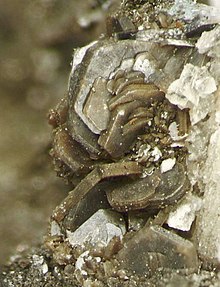| Synchysite-(Ce) | |
|---|---|
 Synchysite-(Ce) from Poudrette quarry, Mont Saint-Hilaire Synchysite-(Ce) from Poudrette quarry, Mont Saint-Hilaire | |
| General | |
| Category | Mineral |
| Formula (repeating unit) | Ca(Ce,La)(CO3)2F |
| IMA symbol | Syn-Ce |
| Strunz classification | 5.BD.20c |
| Dana classification | 16a.1.3.1 |
| Crystal system | Monoclinic |
| Crystal class | Prismatic (2/m) (same H-M symbol) |
| Space group | C2/c |
| Identification | |
| Tenacity | Brittle |
| Mohs scale hardness | 4.5 |
| Luster | Vitreous |
| Diaphaneity | Translucent |
| Pleochroism | Weak |
| References | |
Synchysite-(Ce) is a carbonate mineral and an end member of the synchysite group. The general chemical formula is Ca(Ce,La)(CO3)2F.
Discovery and naming
Synchysite-(Ce) was discovered in 1900 by Gustaf Flink. The name is derived from the Greek "σύγχΰσις", meaning "confounding", a reference to the possibility to confuse the mineral with Parisite-(Ce).
Occurrences
Synchysite-(Ce) is found in rare-earth element bearing pegmatites. It can also occur as a hydrothermal mineral in granite, alkalic syenite and carbonatite.
References
- Warr, L.N. (2021). "IMA–CNMNC approved mineral symbols". Mineralogical Magazine. 85 (3): 291–320. Bibcode:2021MinM...85..291W. doi:10.1180/mgm.2021.43. S2CID 235729616.
- ^ "Synchysite-(Ce)" (PDF). handbookofmineralogy. Retrieved 24 February 2013.
- "Synchysite-(Ce)". Retrieved 24 February 2013.
- Flink, Gustaf (1900). "Ueber den Synchysit". Bull. Geol. Inst. Univ. Upsala: 81.
- "Synchysite-(Ce) Mineral Data". Retrieved 24 February 2013.